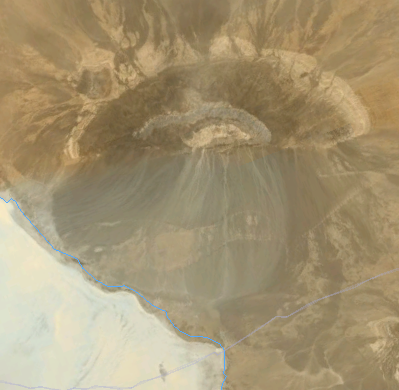It looks like you're using an Ad Blocker.
Please white-list or disable AboveTopSecret.com in your ad-blocking tool.
Thank you.
Some features of ATS will be disabled while you continue to use an ad-blocker.
share:
Still have not managed to post what I was going to post as I got side tracked and found something else just as important , IMO..
let me show you what just happened ...
Here is what i think MIGHT be writing.. I think it says Rah (at this point don't worry if i'm right or wrong, let's just say it does for arguments sake.. )

Now, I began looking for any word that was spelt Rah.. That's all I used.. found this
en.wikipedia.org...
I read that and noticed some guy going on about the ancient Mu and Rah was their sun god.. Funnily enough, Ra is the Egyptian sun god (as we know already)
So I clicked the link for Mu and read;
The cave paintings age... 20,000 to 32,000 Yet another coincidence in these paintings..
en.wikipedia.org...
The symbol for the sun is a a round spot whithin a circle.
The way the Egyptians drew it is like this..
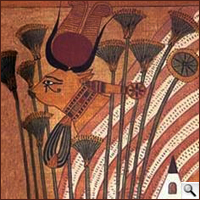
See the "hat" on the cats head.. it is two horns (the circle) encompassing a red spot with two 'feathers' coming out the top..
I think those feathers represent movement as we see depicted many times in the cave paintings, like a comets tail...
so where is this symbol in the cave paintings.. i have found at least four so far..
here is two.. the 'feathers' are at the bottom.. showing which direction they are moving..
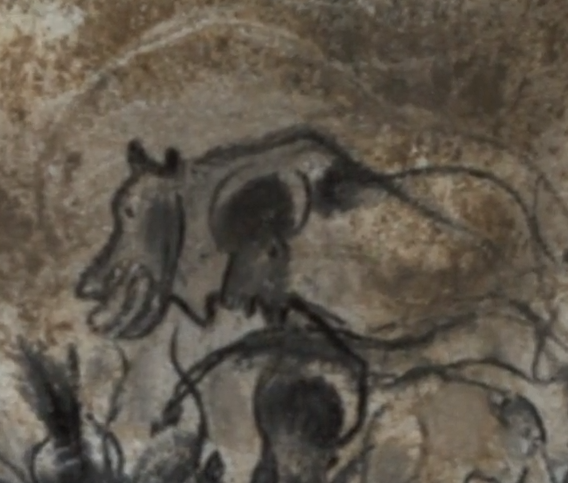
Egyptian art could not redirect the feathers as it spoilt the art.. or the point of showing direction faded over time..
If we find this symbol in other ancient cultures.. then Churchward is proven 3/4's correct.. Mu is/was/possibly his downfall.. a sunken continent.. Made me think on what i said on another post about the Sahara desert.. Hmmm..
Where's my shovel..
Anyway, this is yet another link from ancient Egypt back to the painters of this cave.. and I am about to go hunting for this symbol in other places.. and if I find it.. i think we can safely say there was an ancient culture that traveled many places and gave their knowledge or left their mark.. the mark they left was Ra..
It's interesting also to read what was said about Augustus Le Plongeon (same link as above)
Anyway.. I still need to chase the name of that crater and when it blew its top or got hit.. Now I'm wondering if this submerged city is under the Sahara.. nobody said it had to be water.. It may be that Churchward and Co assumed it was water..
Anyway...
One quick Google search later and we find the Mayan symbol of the sun... A round spot in a circle with two lines coming off it.. (in this case the lines represent the Egyptian feathers or the caves 'comet tails'.)
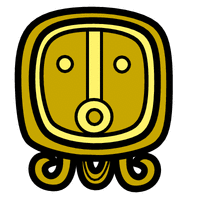
Off to find more now..
let me show you what just happened ...
Here is what i think MIGHT be writing.. I think it says Rah (at this point don't worry if i'm right or wrong, let's just say it does for arguments sake.. )

Now, I began looking for any word that was spelt Rah.. That's all I used.. found this
Rah (slang), British English slang for a young snob
Rah, claimed by James Churchward to be the sun-god of the Mu, and the origin of the Ra of ancient Heliopolis
Rah, a common misspelling for the island of Ra, in north Vanuatu
Rah Rah (band), an indie alternative rock from Regina, Saskatchewan, Canada
Rah!, Rah! is a 1961 studio album by Mark Murphy, arranged by Ernie Wilkins.
Rah!, an album
en.wikipedia.org...
I read that and noticed some guy going on about the ancient Mu and Rah was their sun god.. Funnily enough, Ra is the Egyptian sun god (as we know already)
So I clicked the link for Mu and read;
Churchward gave a vivid description of Mu as the home of an advanced civilization, the Naacal, which flourished between 50,000 and 12,000 years ago, was dominated by a “white race,"[8]: p. 48 and was "superior in many respects to our own"[8]: p. 17 At the time of its demise, about 12,000 years ago, Mu had 64,000,000 inhabitants and many large cities, and colonies in the other continents.
The cave paintings age... 20,000 to 32,000 Yet another coincidence in these paintings..
Churchward claimed that Mu was the common origin of the great civilizations of Egypt, Greece, Central America, India, Burma and others, including Easter Island, and was in particular the source of ancient megalithic architecture. As evidence for his claims, he pointed to symbols from throughout the world, in which he saw common themes of birds, the relation of the Earth and the sky, and especially the Sun. Churchward claims the king of Mu was Ra and he relates this to the Egyptian god of the sun, Ra, and the Rapanui word for Sun, ra’a, which he incorrectly spells "raa."[8]: p. 48 He claimed to have found symbols of the Sun in “Egypt, Babylonia, Peru and all ancient lands and countries – it was a universal symbol.
en.wikipedia.org...
The symbol for the sun is a a round spot whithin a circle.
The way the Egyptians drew it is like this..

See the "hat" on the cats head.. it is two horns (the circle) encompassing a red spot with two 'feathers' coming out the top..
I think those feathers represent movement as we see depicted many times in the cave paintings, like a comets tail...
so where is this symbol in the cave paintings.. i have found at least four so far..
here is two.. the 'feathers' are at the bottom.. showing which direction they are moving..

Egyptian art could not redirect the feathers as it spoilt the art.. or the point of showing direction faded over time..
If we find this symbol in other ancient cultures.. then Churchward is proven 3/4's correct.. Mu is/was/possibly his downfall.. a sunken continent.. Made me think on what i said on another post about the Sahara desert.. Hmmm..
Where's my shovel..
Anyway, this is yet another link from ancient Egypt back to the painters of this cave.. and I am about to go hunting for this symbol in other places.. and if I find it.. i think we can safely say there was an ancient culture that traveled many places and gave their knowledge or left their mark.. the mark they left was Ra..
It's interesting also to read what was said about Augustus Le Plongeon (same link as above)
The idea of Mu first appeared in the works of Augustus Le Plongeon (1825–1908), after his investigations of the Maya ruins in Yucatán.[1] He claimed that he had translated the ancient Mayan writings, which supposedly showed that the Maya of Yucatán were older than the later civilizations of Greece and Egypt, and additionally told the story of an even older continent.
Anyway.. I still need to chase the name of that crater and when it blew its top or got hit.. Now I'm wondering if this submerged city is under the Sahara.. nobody said it had to be water.. It may be that Churchward and Co assumed it was water..
Anyway...
One quick Google search later and we find the Mayan symbol of the sun... A round spot in a circle with two lines coming off it.. (in this case the lines represent the Egyptian feathers or the caves 'comet tails'.)

Off to find more now..
edit on 27-12-2012 by Extralien because: (no reason given)
excellent DOT connecting and a fantastic thread.....
thank you so much for a good read......
you may be onto something here......
thank you so much for a good read......
you may be onto something here......
Originally posted by cantsee4looking
you may be onto something here......
I've had that feeling ever since the 21/12/12.. the day i watched the documentory on the caves.
I'm finding it a bit hard to turn the computer off.. waking up early in the mornings too..
Had animage in my head last night whilst asleep.. It was buried somewhere in the paintings.. like a man sitting in a chair.. some form of cross hatch art was obscuring him.. can't find it in the real paintings...yet
Fantastic you found the name of the ancient ancients,
out of everything that's written on this graham hancock and co
i don't think they ever found their name (i could be wrong i havn't read e-thing)
your a busy bee ey
keep it coming
out of everything that's written on this graham hancock and co
i don't think they ever found their name (i could be wrong i havn't read e-thing)
your a busy bee ey
keep it coming
Originally posted by cjttatu
Fantastic you found the name of the ancient ancients,
out of everything that's written on this graham hancock and co
i don't think they ever found their name (i could be wrong i havn't read e-thing)
your a busy bee ey
keep it coming
They did not have the cave paintings or didn't bbother to look.. or looked and didn't see..
But yes, if Churchward was right about the name.. yes.. i guess i have.. or at least the evidence to say they existed and did as Churchward and Co said they did..
to add to the sun thing..
This is the Aztecs
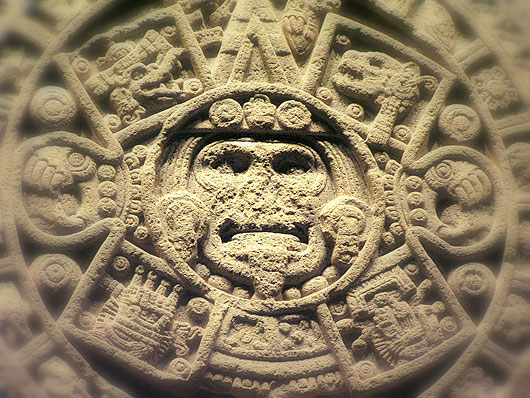
A round spot (the face) in a circle with two lines coming off.. (though they converge here)
This is the Aztecs

A round spot (the face) in a circle with two lines coming off.. (though they converge here)
I'm not going to lie, I had a hard time at first, seeing some of the same things you have.
That being said, the hippo, compared to the Egyptian hippo, should be making many people scratch their heads. That one just jumps right out at you.
I just cannot believe that is a coincidence.
Wonderful thread!
Thank you for all your hard work!
That being said, the hippo, compared to the Egyptian hippo, should be making many people scratch their heads. That one just jumps right out at you.
I just cannot believe that is a coincidence.
Wonderful thread!
Thank you for all your hard work!
reply to post by chiefsmom
Yes, it is a bit hard to try to see what I see...especially when it's me doing the explaining
Thanks for your kind words though.. and yes, there are waytoo many coincidences going on in this little lot.. am just preparing another post with another coincidence...so stick around.. wont be long..
Yes, it is a bit hard to try to see what I see...especially when it's me doing the explaining
Thanks for your kind words though.. and yes, there are waytoo many coincidences going on in this little lot.. am just preparing another post with another coincidence...so stick around.. wont be long..
As I've tried to explain, these cave paintings are all about angles, shades, lighting, textures and more..
Whilst searching through it all, I cam across the sealed vase..and just above it was this..
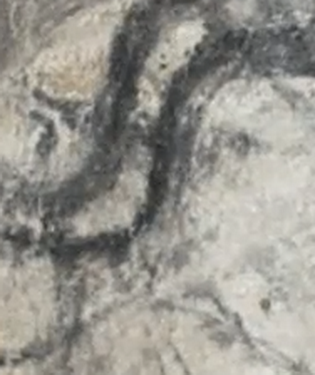
doesn't look like much does it..
It's a bit more 'complete' in the main picture but this image is being deliberately hidden.. this is a hint of something else..
would you agree that under those two big thick black lines you can see some faint lines that resemble a triangle..
Or a pyramid???
I myself was doubtfull and had been until today..
I was going over the documentory again and was looking for something else when the camera angle caught my attention on something..
It was big, very thick black and stuck out like a sore thumb in comparison to everything else..
Here it is..
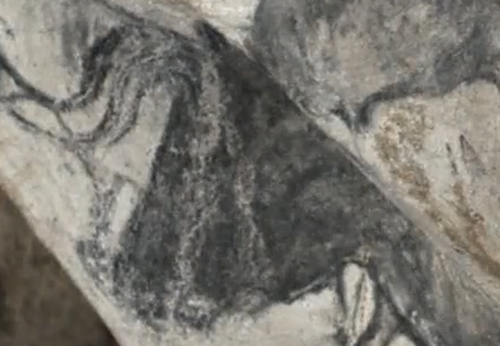
Pyramid anyone?
Is this the first design ? the first plan?
Or something much, much more powerful??
The reason I suggest that is due to an image I have seen that I am working on and trying to get the best representationout of it as I know these guys love to hide their little lifestyles..
anyway.. Pyramid???
Whilst searching through it all, I cam across the sealed vase..and just above it was this..

doesn't look like much does it..
It's a bit more 'complete' in the main picture but this image is being deliberately hidden.. this is a hint of something else..
would you agree that under those two big thick black lines you can see some faint lines that resemble a triangle..
Or a pyramid???
I myself was doubtfull and had been until today..
I was going over the documentory again and was looking for something else when the camera angle caught my attention on something..
It was big, very thick black and stuck out like a sore thumb in comparison to everything else..
Here it is..

Pyramid anyone?
Is this the first design ? the first plan?
Or something much, much more powerful??
The reason I suggest that is due to an image I have seen that I am working on and trying to get the best representationout of it as I know these guys love to hide their little lifestyles..
anyway.. Pyramid???
reply to post by Extralien
The fourth picture down looks like a panther and a lion. The panther really stuck out at me. If it is a map of sorts with trade routes one must consider the worship of the panther by the Olmecs and the descendant cultures.
This painting then would have to be made by some one with an aerial view. Was he a grounded pilot of a craft that could travel the world? I am a proponent of ancient advanced humans or like wise beings.
Was he stranded there and tried to occupy his time telling a story of his life and what he had seen?
I love this thread! So great.
The fourth picture down looks like a panther and a lion. The panther really stuck out at me. If it is a map of sorts with trade routes one must consider the worship of the panther by the Olmecs and the descendant cultures.
This painting then would have to be made by some one with an aerial view. Was he a grounded pilot of a craft that could travel the world? I am a proponent of ancient advanced humans or like wise beings.
Was he stranded there and tried to occupy his time telling a story of his life and what he had seen?
I love this thread! So great.
Interesting.......maybe
I found anagrams for my name once a while back and I came up with "Beige Jackal"
Not Horus, but .......Anubis! Anubis was a beige jackal; the guardian of the underworld. Although this might not mean anything, its interesting to believe it does. Like I'm connected to some bigger scheme of things. Like I said might not mean a thing, but it's nice to think about.
I feel like there is a bigger picture going on in the background of our history in this world, but we just aren't quite there with putting the puzzle together.
Content source: www.kwintessential.co.uk...
I love anagrams
-83
I found anagrams for my name once a while back and I came up with "Beige Jackal"
Not Horus, but .......Anubis! Anubis was a beige jackal; the guardian of the underworld. Although this might not mean anything, its interesting to believe it does. Like I'm connected to some bigger scheme of things. Like I said might not mean a thing, but it's nice to think about.
I feel like there is a bigger picture going on in the background of our history in this world, but we just aren't quite there with putting the puzzle together.
Egyptian Jackal Mythology The ancient Egyptian jackal can be seen depicted in the form of a jackal headed god that was popularly known as Anubis. The majority of descriptions show the jackal headed god with a black colored head that is characterized by its long ears along with a pointed muzzle just like the actual animal. Anubis the jackal god is regarded as being one of the most significant mythological symbols of ancient Egypt. He was regarded as being the God of burial rituals. It was also believed that Anubis judged each soul upon its death and assigned it its designated place. Anubis was regarded as being the ruler of the underworld and the protector of the dead. Egyptian Jackal Characteristics The Egyptian jackal was characterized by its lanky structure and a thick fur coating. It appeared to be grey-beige in color although a dirty yellow shade may also be found. It had characteristic long and pointing ears that could be seen from a distance extending above its thin body. The locals referred to the Egyptian jackal as the wucharia. The Saharan wolf is considered to be a subspecies of this ancient animal. Although lanky in its appearance the Egyptian jackal is relatively heavier and larger than other species of jackals. Many critics argue that the Egyptian jackal should actually be classified as a smaller Desert wolf rather than a breed of jackal. This is primarily because of its dental measurements and the Carnal nature of its dentures. The Egyptian jackal has an elongated upper jaw with a flat bottom jaw. Over the years extensive research has been conducted on the genetic structure of the Egyptian jackal. The latest DNA research has caused scientists and zoologists to classify the Egyptian jackal as a variation of the golden jackal had not a subspecies of the gray wolf. A number of elements from the physical structure of the Egyptian jackal caused scientists to consider it as a variation of the gray wolf. These were primarily its large ears, long legs and a body that resembled that of a wolf more than that of the conventional jackal. Nonetheless scientific research has proved it to be closer to the breed of jackals than wolves. Today the ancient Egyptian jackal can hardly be seen. The largest population of this species was in the western desert of Egypt and other areas such as Kharga, Dakhla and Siwa as well as certain areas near Cairo. Although the animal has now made it to the endangered species list because of over hunting yet there are no laws that restrict the hunting of this animal in Egypt.
Content source: www.kwintessential.co.uk...
I love anagrams
-83
edit on 27-12-2012 by unb3k44n7 because: (no reason given)
When I look at the eye of Horus I see an island in the pacific surrounded by coconut trees and 6' surf. An airplane comes in to land (because it's a
ski plane) and offloads another weeks of supplies and a single newspaper. The waterfall at the upper part of the island cascades down and fills a cool
clear pool we swim in every day.
The desert picture. I just see sand.
My point is, you're seeing nothing but what you 'want' to see.
Psychiatrists will help you discover its a desert. Did you know there is an Indian in a head dress in the Sahara? That obviously means the Americans Indians came from Egypt aye! (Nope !) It means there is a rock formation that at the angle of a bird looks like something we knew existed between 1500-1800 in the USA
The desert picture. I just see sand.
My point is, you're seeing nothing but what you 'want' to see.
Psychiatrists will help you discover its a desert. Did you know there is an Indian in a head dress in the Sahara? That obviously means the Americans Indians came from Egypt aye! (Nope !) It means there is a rock formation that at the angle of a bird looks like something we knew existed between 1500-1800 in the USA
Originally posted by Extralien
When you look at this picture, what do you think you see?
A crater?
Don’t know?
Eye of Horus?
A floating jelly fish? A brain suspending in fluid? A ninja-turtle? My mother?
But most of all.....a crater.
Seriously, I see all of those things before I see the Eye of Horus.
Your other "Eye of Horus" interpretations look nothing like it to me - there isn't even the pupil.
Look at the bear/lions head.. it’s ears are not ears.. they’re the eyes of a feline.. more of a cat than a lion.. The eye and curved cheek line of the bear/lion is in fact the nose and mouth of the feline.
If you look carefully, you can even see whiskers and the “whisker freckle” cats have. It’s an unusual looking breed and may possibly now be extinct.. but why hide this image in such a manner? I may have an answer for that and will include this later.
Again, I stared at this one for ages trying to see what you are seeing and couldn't get it at all. It looked a bit like a hippo for me, and then when you close in on the image it looked like a frog. Also, genetic studies show that cats didn't start domesticating until about 10,000 years ago - descending from African wild cats - so it is unlikely whatever you are seeing is from a "breed" of any kind.
It was at this point that I knew I had completely lost the plot and should be on a one way ticket outta here.
I honestly think you were completely correct with this assessment and should have gone with it, as it just gets weaker and weaker.
Your "map" showing "trade routes" appears to be using cracks in the rock, and isn't even remotely like the actual geography of the area you claim it depicts.
We may find that we will have to progress another 200 or even 500 years before we have a state of knowledge that matches this previous intelligence level.
So we are capable of cave paintings?
Credit to loads of work by the OP and others.
This is surely an exercise in making the fantasy fit the picture.
What do you see? I am sure I can see Cleopatra looking back at me.
Regards
This is surely an exercise in making the fantasy fit the picture.
What do you see? I am sure I can see Cleopatra looking back at me.
Regards
edit on 28/12/2012 by paraphi because: Removed link as I cannot get it to work.
Originally posted by FatherLukeDuke
Seriously, I see all of those things before I see the Eye of Horus.
It looked a bit like a hippo for me, and then when you close in on the image it looked like a frog. Also, genetic studies show that cats didn't start domesticating until about 10,000 years ago - descending from African wild cats - so it is unlikely whatever you are seeing is from a "breed" of any kind.
Your "map" showing "trade routes" appears to be using cracks in the rock, and isn't even remotely like the actual geography of the area you claim it depicts.
So we are capable of cave paintings?
I think you have not read what I've said properly.
The entire cave paintings have been deliberately done in a way as to obscure or hide the truth whilst leaving everything in plain sight for those who know how to read it or see into it.
well, to help you out a little...does this work for you?
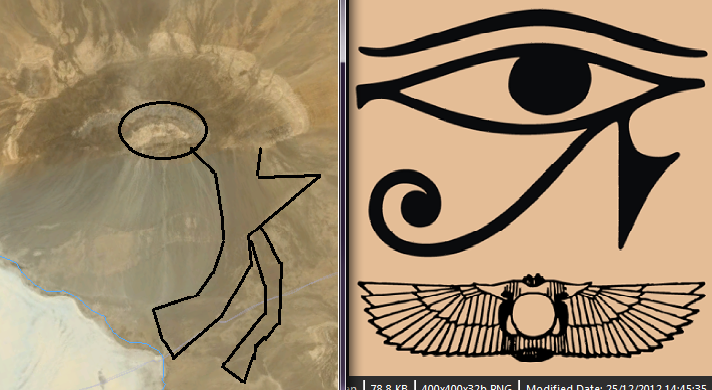
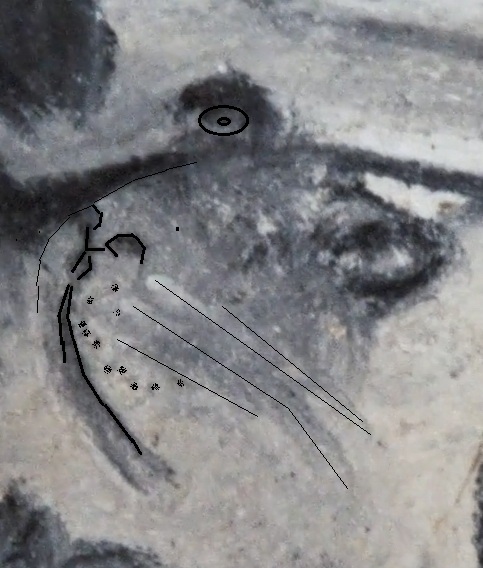
Hope that helps..
As for the domestication of cats starting approx. 10,000 years ago, that still leaves 10,000 years between the cave being sealed and our current domestication ideas..
Either someones gotten the history books wrong, or we stopped domesticating for 10,000 to 20,000 years..
30,000 years is a long time for genetic lines to change or go missing.. hence my thoughts about that "cat" possibly being the face of the Sphinx..
Originally posted by Extralien
I think you have not read what I've said properly.
I think I have, I just don't buy it.
The entire cave paintings have been deliberately done in a way as to obscure or hide the truth whilst leaving everything in plain sight for those who know how to read it or see into it.
That's your opinion. My opinion is that you are lost amongst smoke and mirrors of your own creation. One can look at any work of art and decide that the artist was hiding secret messages - once you have done that you can read literally anything into it you like.
well, to help you out a little...does this work for you?
No, not even slightly. I've no idea why you have drawn the lines where you have, but even then it looks nothing like an Eye of Horus.
Hope that helps..
I actually laughed out loud at that, I'm afraid to say. Why does it have one mad staring eye in it's ear? Why have you drawn some lines that I presume are meant to be whiskers on it? I don't think many people will find that convincing, IMO.
As for the domestication of cats starting approx. 10,000 years ago, that still leaves 10,000 years between the cave being sealed and our current domestication ideas..
Either someones gotten the history books wrong, or we stopped domesticating for 10,000 to 20,000 years..
The age of domestic cats is done through genetic dating. However there is always the possibility that humans domesticated cats more than once, I'll give you that. However we are probably off the point.
reply to post by Extralien
I dunno how I missed this presentation.
I'm only half way through the first page but wanted to give this thread a bump.
S & F
I dunno how I missed this presentation.
I'm only half way through the first page but wanted to give this thread a bump.
S & F
Going on the connections with the eye of Ra/Horus being the sun god and the 'logo' associated with that (a round spot in a circle ((usually)) with a
comet like tail) and the writings of Churchward and Co, in particular,
en.wikipedia.org...
I thought I'd try to find some other far away connections
So i began searching for images from various locations and found a few that relate rather closely to some images from the cave.
Sumerian
This image relates to the face in the 'collar' on the lion
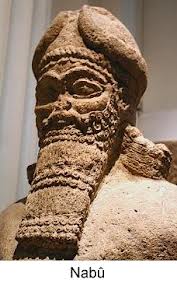
and the collar..

This one relates to the way the horses are stacked, (as the Egyptians presented also) like the rhinos in the caves
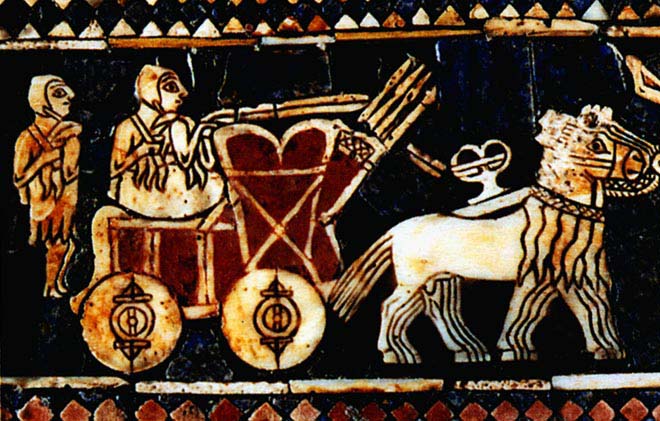
An archway? Maybe this is the tree of life.. (archway is to the left at a slight angle)
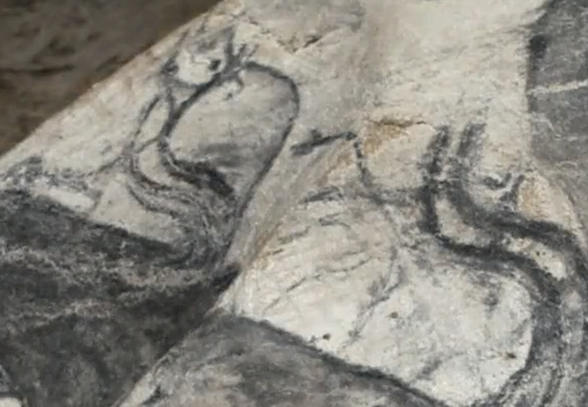
Sumerian
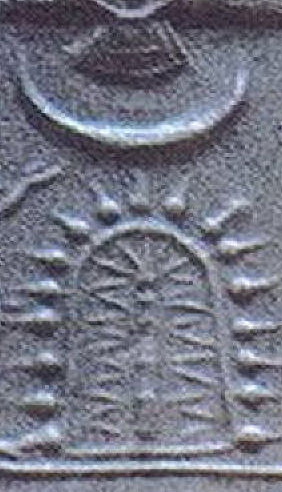
Ancient Urartu ulture tree of life
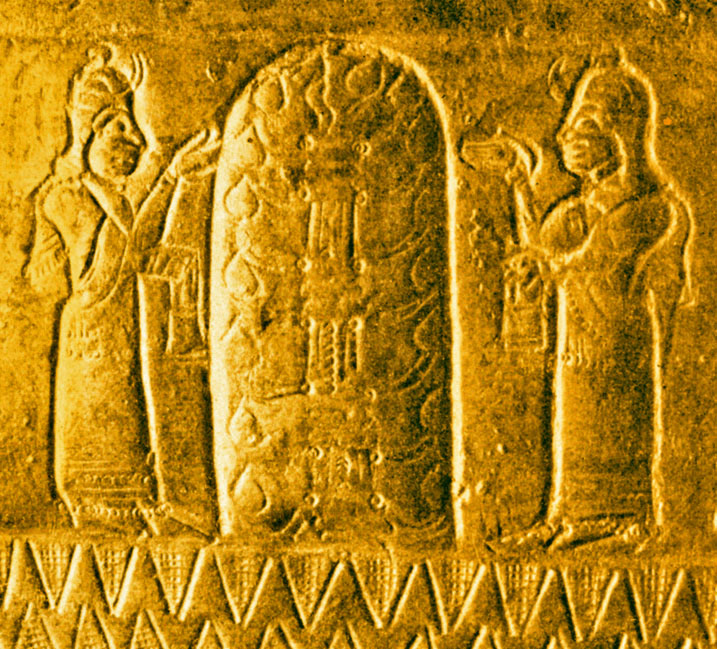
Aztec and Egyptian side by side
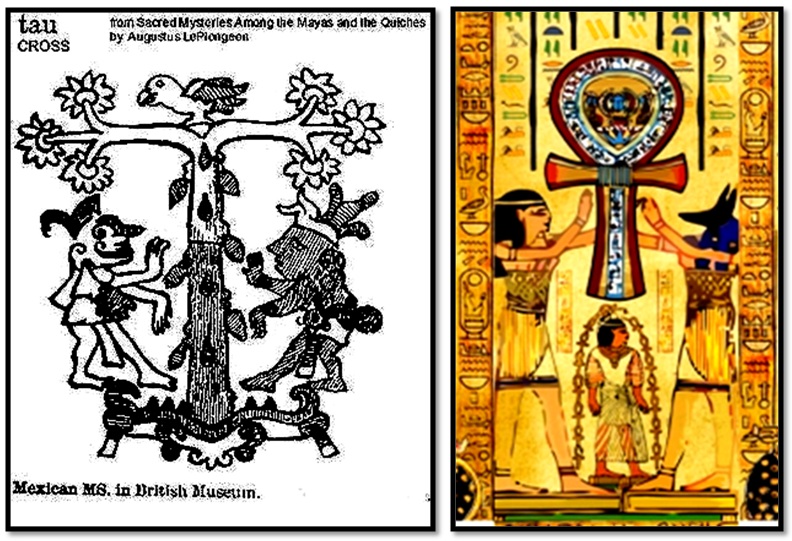
Celtic tree of life
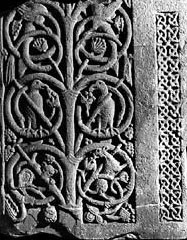
And i was hoping to find the ankh in all of this somewhere..
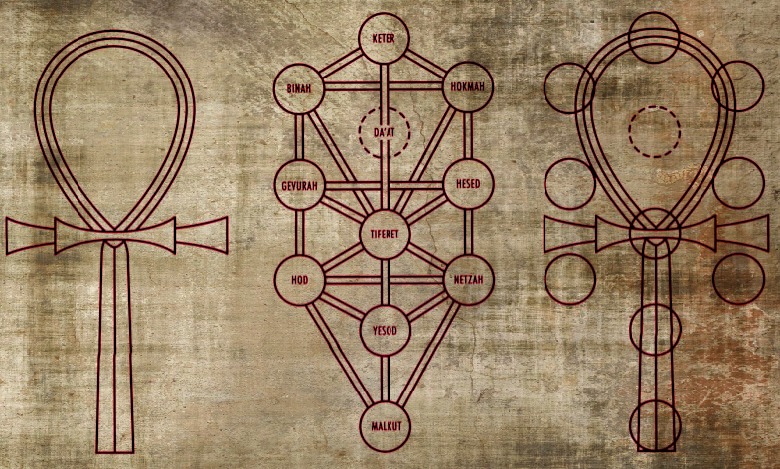
Easter Island
Here we have a rock formation of the image that represents the sun. (please notice the "third rock from the sun")

This popular image of a 'birdman'on Easter island is also seen in the cave.
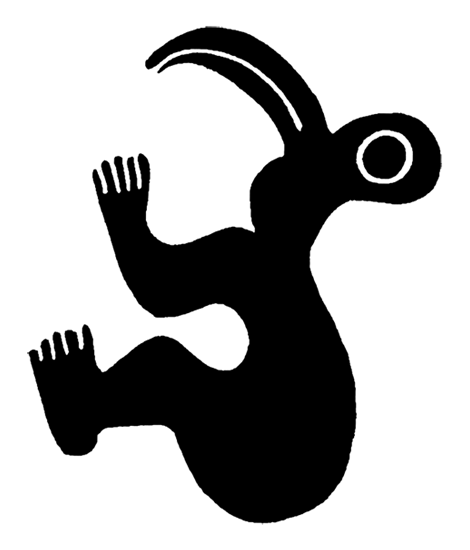
This is the caves birdman
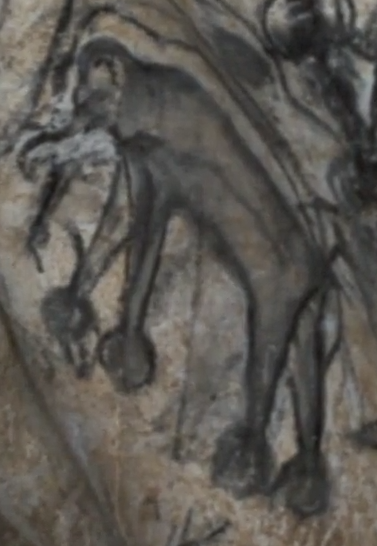
Assyrian birdman

Mexican Pyramid of Tlahuizcalpanteuctli, bird-man.
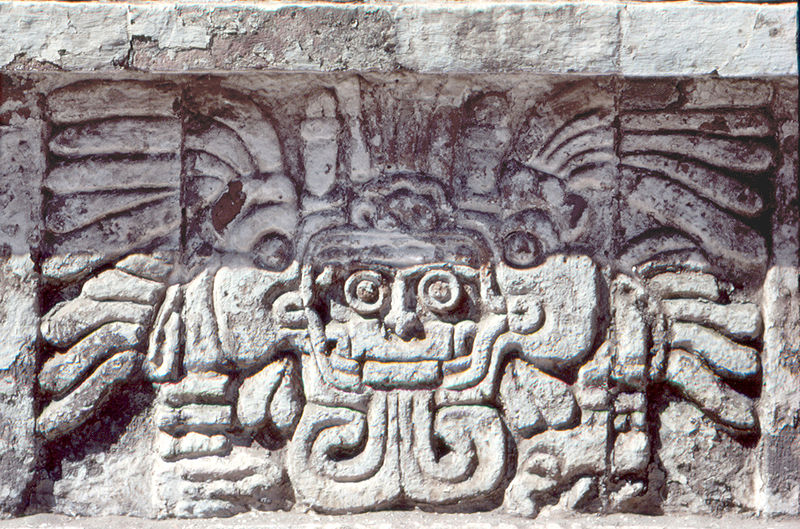
Just a few samples.. other wise I'll be here for the next half ofmy life finding and posting pics..but you get the idea.
What with everything else, I'd say that was just a few coincidences too many..
Are we looking at the base culture of a civilization that spanned over half the Earth for a long time? Has all that they knew and learnt been passed down to us through folk tales and religious writings and texts? How much of our past have we lost?
How much more can be discovered in the paintings of the Chauvet caves??
the Naacal, which flourished between 50,000 and 12,000 years ago, Churchward claimed that Mu was the common origin of the great civilizations of Egypt, Greece, Central America, India, Burma and others, including Easter Island, and was in particular the source of ancient megalithic architecture. As evidence for his claims, he pointed to symbols from throughout the world, in which he saw common themes of birds, the relation of the Earth and the sky, and especially the Sun.
en.wikipedia.org...
I thought I'd try to find some other far away connections
So i began searching for images from various locations and found a few that relate rather closely to some images from the cave.
Sumerian
This image relates to the face in the 'collar' on the lion

and the collar..

This one relates to the way the horses are stacked, (as the Egyptians presented also) like the rhinos in the caves

An archway? Maybe this is the tree of life.. (archway is to the left at a slight angle)

Sumerian

Ancient Urartu ulture tree of life

Aztec and Egyptian side by side

Celtic tree of life

And i was hoping to find the ankh in all of this somewhere..

Easter Island
Here we have a rock formation of the image that represents the sun. (please notice the "third rock from the sun")

This popular image of a 'birdman'on Easter island is also seen in the cave.

This is the caves birdman

Assyrian birdman

Mexican Pyramid of Tlahuizcalpanteuctli, bird-man.

Just a few samples.. other wise I'll be here for the next half ofmy life finding and posting pics..but you get the idea.
What with everything else, I'd say that was just a few coincidences too many..
Are we looking at the base culture of a civilization that spanned over half the Earth for a long time? Has all that they knew and learnt been passed down to us through folk tales and religious writings and texts? How much of our past have we lost?
How much more can be discovered in the paintings of the Chauvet caves??
edit on 28-12-2012 by Extralien because: (no reason given)
edit on 28-12-2012 by Extralien because: (no reason given)
Originally posted by SLAYER69
reply to post by Extralien
I dunno how I missed this presentation.
I'm only half way through the first page but wanted to give this thread a bump.
S & F
Really glad to have you here Slayer..
I'm certain your knowledge on this is going to be incredibly helpful here.
so very appreciated. Love your latest thread too..
Originally posted by chiefsmom
I'm not going to lie, I had a hard time at first, seeing some of the same things you have.
That being said, the hippo, compared to the Egyptian hippo, should be making many people scratch their heads. That one just jumps right out at you.
I just cannot believe that is a coincidence.
Wonderful thread!
Thank you for all your hard work!
Well as Enstein once said and sorry I am on an Enstein kick from another thread:
"Coincidence is God's way of remaining anonymous"
new topics
-
To become president, Zelensky had to learn Ukrainian
Political Conspiracies: 18 minutes ago -
Green Grapes
General Chit Chat: 4 hours ago -
Those Great Fresh Pet Commercials
Television: 9 hours ago -
S.C. Jack Smith's Final Report Says Trump Leads a Major Conspiratorial Criminal Organization!.
Political Conspiracies: 11 hours ago
top topics
-
Joe meant what he said about Hunter's pardon....
US Political Madness: 13 hours ago, 11 flags -
S.C. Jack Smith's Final Report Says Trump Leads a Major Conspiratorial Criminal Organization!.
Political Conspiracies: 11 hours ago, 11 flags -
Advice for any young Adult .
General Chit Chat: 12 hours ago, 10 flags -
Green Grapes
General Chit Chat: 4 hours ago, 5 flags -
It’s Falling…
Philosophy and Metaphysics: 15 hours ago, 4 flags -
Regent Street in #London has been evacuated due to a “bomb threat.”
Other Current Events: 13 hours ago, 3 flags -
Those Great Fresh Pet Commercials
Television: 9 hours ago, 3 flags -
To become president, Zelensky had to learn Ukrainian
Political Conspiracies: 18 minutes ago, 1 flags
active topics
-
S.C. Jack Smith's Final Report Says Trump Leads a Major Conspiratorial Criminal Organization!.
Political Conspiracies • 40 • : GotterDameron23 -
House Passes Laken Riley Act
Mainstream News • 22 • : KrustyKrab -
To become president, Zelensky had to learn Ukrainian
Political Conspiracies • 0 • : Imhere -
Los Angeles brush fires latest: 2 blazes threaten structures, prompt evacuations
Mainstream News • 107 • : Vermilion -
Russia Ukraine Update Thread - part 3
World War Three • 6904 • : Imhere -
Steering the Titantic from the Drydock.
Rant • 43 • : charlest2 -
What Comes After January 20th
Mainstream News • 33 • : underpass61 -
President Carter has passed
Mainstream News • 44 • : WeMustCare -
Those stupid GRAVITE commercials
Rant • 13 • : GENERAL EYES -
-@TH3WH17ERABB17- -Q- ---TIME TO SHOW THE WORLD--- -Part- --44--
Dissecting Disinformation • 3973 • : duncanagain

